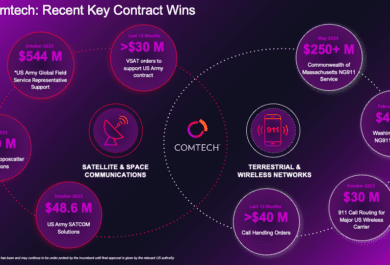Cybersecurity must be built into the core culture of an organization if it’s going to successfully protect against increasingly sophisticated threats and support the ongoing convergence of global communications infrastructures.
The secret to success, according to Comtech’s Chief Strategy Officer – Defense, Daniel Gizinski, is approaching cyber protection a lot like your daily morning hygiene routine. “Cybersecurity really must become as routine as brushing your teeth or washing your hands,” explains Gizinski. “We need to live and breathe cyber hygiene as part of daily operations and not write the challenge off as a few lines of official policy. Skipping cybersecurity for even a day can open the door enough to allow an adversary to walk through.”
Today, Comtech is building cybersecurity into every aspect of its business. Comtech’s people, processes, and technologies support end users’ ability to stay one step ahead to defend against today’s most sophisticated cyber threats across commercial, government, and international markets.
In light of recent cyberattacks, government agencies and businesses have become much savvier with their cyber practices and overall security posture. They appreciate more than ever the risk of lost revenue and lost customer trust in the wake of cyber breaches, according to Gizinski. He says government and commercial markets are demanding more cybersecurity discipline and knowledge from their solution and service providers, as they define, design, and deploy security architectures.
“Today’s most effective cybersecurity solutions aren’t just about hardware, systems and software, they provide an end-to-end view into the security layers required to keep an operation safe today and well into the future,” says Gizinski, pointing to Comtech’s cybersecurity technology leadership across the company.
Demand Growing for Smart Flexible Cyber Solutions
The U.S. Government recently ramped up adjustments to its cybersecurity policies with an aim to get out in front of changing risks. Today, cyber threats will only grow as people’s daily lives depend more and more on increasingly complex communications networks and services, ranging from cloud technologies, national security operations, Internet of Things (IoT) applications, and access to always-on connectivity, whether you’re on an airline or connecting to the internet in a remote region of the world.
At Comtech, cybersecurity and other security features are considered and integrated from the very beginning of the design and development process. The company’s security solutions are also designed to readily evolve to stay ahead of the changing threat landscape. “Government, defense and commercial operations are absolutely relying and running on Comtech communications systems and platforms, so they must have adaptable security capabilities built in to meet changing threats,” Gizinski explains. Comtech builds software-defined, future-proof cybersecurity into its platforms, enabling customers to easily make security updates to their systems quickly as new threats surface.
“Government and commercial customers can’t ship their systems back to us to apply current cyber updates. That’s just not feasible,” says Gizinski. “Our products have a built-in software-defined architecture that allows the devices to be updated as necessary – easily, remotely and transparently.”
We are on the cusp of an unprecedented paradigm shift in cybersecurity as advances in Artificial (AI) Intelligence and Machine Learning (ML) provide opportunities for both bad actors and defensive cyber professionals to automate processes the require a human in the loop today. AI/ML techniques are being used today to adaptively predict threat vectors in advance, enabling proactive, tailored defensive planning. In many cases we’ve seen advanced defensive techniques that have been able to lead bad actors into walled gardens, turning the tables and enabling cyber researchers to study the threats in a controlled environment.
Comtech contributes to and monitors new military and commercial security standards, including zero trust to network frameworks released by the Department of Defense. The company is consistently ensuring its people, who are developing next-generation solutions and services, are well ahead of the technology curves and well informed on future threats and how to innovate to keep them at bay.
A Leader in Cyber Training
Comtech not only integrates cybersecurity across its technologies, solutions, and services, but also runs a leading cyber training program to keep the US Government and a wide range of commercial companies ahead of the ever-changing threat landscape.
Through Comtech’s CyberStronger program, the company delivers differentiated cybersecurity services and trainings to commercial and government customers around the world.
“We provide cybersecurity services sought out by intelligence, military, and government security organizations around the world,” said Gizinski. “Our technologies ensure our military and government customers have some of the most robust cyber skills and capabilities available to safeguard information and deter adversaries.”
Building the cyber resilient workforce of tomorrow is a critical challenge for all organizations, and there’s a cyber security skills shortage across the board – 500,000 workers in the US alone and 3.4 million worldwide are needed to develop solutions and combat threats.
Drawing on nearly two decades of experience, Comtech is filling today’s cyber workforce development gap by delivering the knowledge, skills, and technologies needed to prepare the cyber leaders of today as well as the next generation of cybersecurity experts.
“Comtech has been delivering training for the Department of Defense and other government agencies for decades,” explained Gizinski. “We’re also providing key training tools and solutions to universities and corporations.” Comtech is focused on delivering the knowledge, skills, and abilities (KSAs) necessary for government and corporate employees and teams to perform security roles aligned with the National Institute for Cybersecurity Education (NICE) framework.
As communications infrastructures evolve, this knowledge and Comtech’s trainings will be even more important for nearly every commercial and government organization imaginable.
A Zero Trust Future
The growth of hybrid and converged networks is driving the demand for layered zero trust security architectures that can quickly put-up additional protections around critical data.
Hybrid networks and converged communications infrastructures are designed to offer far more resiliency overall, but they can also introduce more complexity, according to Gizinski. “Fundamentally, you can sometimes wind up with a network that’s only as strong as its weakest link, especially if you’re employing a legacy or traditional perimeter-based security model that requires manual processes,” he notes. “Once the threat permeates through the weak spot, it has access to broad swaths of the network.” Moving from a perimeter-based security architecture to a Zero Trust approach that provides defense in depth is key, but it must be done in a way that doesn’t unduly burden the end user.
For example, you may not even recognize that your phone is actually validating that it’s you when you pick up the device through a fingerprint or facial recognition. “That’s the real trick to zero trust. You’re adding in these layers of verification and authentication in a way that’s seamless to the user, and doesn’t interrupt the network connection,” Gizinski explains.
Zero trust is increasingly important as organizations rely more and more on hybrid and converged networks. As communications infrastructures continue to mesh together, cybersecurity and secure data transmission must also evolve to meet the incredible amount of information these networks will handle and transfer on daily basis. According to Gizinski, “Comtech is always ensuring users are not just reliant on perimeter security by providing systems that are constantly revalidating and moderating traffic across the network.”
With the future of hybrid networks in mind, Comtech is uniquely positioned to provide the end-to-end cybersecurity services, trainings, and technologies needed to support the blending of space, satellite, terrestrial, and wireless infrastructures.
At the end of the day, for Gizinski, “it comes down to an organization’s commitment to building a culture of cybersecurity. That level of routine dedication and constant advancements in future-proof technologies will ensure you’ve always got the very best security systems in place to keep operations safe and secure.”
Today, Comtech is operating with a security first mindset when it comes to every aspect of its business across the enterprise. As the company moves forward with connecting the unconnected and democratizing access to communications technologies around the world, Comtech’s cyber first mentality will continue to sit at the core to ensure customers have some of the most robust cyber capabilities available to safeguard information and deter threats as the connectivity landscape continues to evolve.
Forward-Looking Statements
Certain information in this blog contains statements that are forward-looking in nature and involve certain significant risks and uncertainties. Actual results and performance could differ materially from such forward-looking information. The Company’s Securities and Exchange Commission filings identify many such risks and uncertainties. Any forward-looking information in this press release is qualified in its entirety by the risks and uncertainties described in such Securities and Exchange Commission filings.


